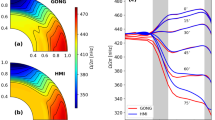Abstract
This paper points out the basic relation between the conversion of thermal energy into convective fluid motion (Alfvén waves when a strong vertical magnetic field is present) and the convective transport of thermal energy. It is shown that heat transport necessarily accompanies convective driving of fluid motion. Convective motions restricted to a layer whose thickness is a small fraction of the local scale height can divert no more than the same fraction of the energy into Alfvén waves. But if the convecting layer extends over many scale heights, then the convective forces may convert more energy into fluid motion than they transport. Hence the creation of a cool sunspot requires convection extending coherently over several scale heights, at least 500 km. This requirement is basically just the familiar thermodynamic efficiency of an ideal heat engine. The calculations establish that convection need not be much less efficient than the ideal.
Similar content being viewed by others
References
Chandrasekhar, S.: 1961,Hydrodynamic and Hydromagnetic Stability, Oxford, Clarendon Press.
Chitre, S.: 1963,Monthly Notices Roy. Astron. Soc. 126, 431.
Giovanelli, R. G.: 1972,Solar Phys. 27, 71.
Gokhale, M. K. and Zwaan, C.: 1972,Solar Phys. 26, 52.
Parker, E. N.: 1973,Astrophys. J. 186, 643, 665.
Parker, E. N.: 1974a,Solar Phys.,36, 249.
Parker, E. N.: 1974b,Solar Phys. 37, 127.
Rossbach, M. and Schröter, E. H.: 1970,Solar Phys. 12, 95.
Savage, B. D.: 1969,Astrophys. J. 156, 707.
Spiegel, E. A.: 1971,Ann. Rev. Astron. Astrophys. 9, 323.
Spiegel, E. A.: 1972,Ann. Rev. Astron. Astrophys. 10, 261.
Van der Borgt, R.: 1974,Monthly Notices Roy. Astron. Soc. 166, 191.
Author information
Authors and Affiliations
Additional information
This work was supported in part by the National Aeronautics and Space Administration under Grant NGL 14-001-001.
Rights and permissions
About this article
Cite this article
Parker, E.N. The nature of the sunspot phenomenon. Sol Phys 40, 275–289 (1975). https://doi.org/10.1007/BF00162375
Received:
Revised:
Issue Date:
DOI: https://doi.org/10.1007/BF00162375



